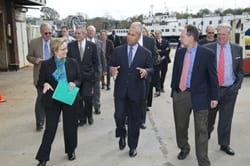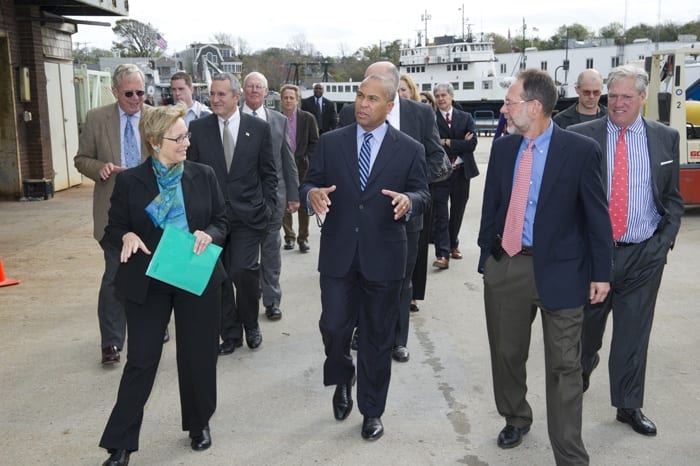Mass. Governor Deval Patrick Makes First Visit to WHOI

October 12, 2011
The Woods Hole Oceanographic Institution (WHOI) hosted a visit Wednesday, October 12, by Massachusetts Governor Deval Patrick, marking his first visit to the Cape-based non-profit ocean research, engineering, and education organization.
“The Institution is honored to host the governor,” said WHOI President and Director Susan Avery. “WHOI is an international leader in advancing ocean sciences and technology, leading to new knowledge, methodologies, vehicles, instruments, and sensors. Because our work has applications in other domains—for example, climate change adaptation, national security, offshore energy, and forensic search and survey—it leads to creation of local jobs and businesses and contributes to the vibrancy of the high tech sector in the Commonwealth.”
Governor Patrick was accompanied on his on visit by Massachusetts Secretary of Energy and Environmental Affairs Richard Sullivan and Raytheon Chairman and CEO William H. Swanson.
“Woods Hole Oceanographic Institution shines a light on the future of oceanographic research, and Massachusetts is proud to have this cutting edge facility here,” said Governor Patrick. “Our investments in education, innovation, and infrastructure make Massachusetts an attractive place for research and development, and WHOI’s continued success shows that our growth strategy is working.”
During his 90-minute visit to WHOI, Governor Patrick toured several of the Institution’s labs and was briefed on its robotic vehicle development and ocean observing programs.
In the WHOI Ocean Systems Lab, Mike Purcell briefed Gov. Patrick on the REMUS autonomous underwater vehicle (AUV), which was developed at WHOI with major funding from the U.S. Navy and is now licensed and manufactured by the Cape-based company Hydroid. Purcell, a WHOI senior engineer and the project lead on the successful search in the Atlantic Ocean earlier this year for the wreckage of Air France flight 447, will be joined by Chris Von Alt, president and CEO of Hydroid, which built the REMUS 6000 vehicles used to locate the plane’s wreckage.
The governor also was briefed by Andy Bowen, director of the National Deep Submergence Facility and principal engineer of Nereus—currently the only vehicle capable of reaching the deepest ocean trenches. Nereus can operate either autonomously or controlled from the surface by way of an ultra-thin fiber-optic tether. The fiber-optic tether allows two-way communication from the vehicle to operators on the surface, and eliminates the costly ship and cable handling requirements of a standard remotely-controlled vehicle. Future Nereus missions will venture beneath the Arctic ice, and advances in sensor payload and onboard processing will make it possible for vehicles to make sense of their underwater environment, and adjust their mission accordingly. WHOI Associate Scientist Richard Camilli described his work on the instrument TETHYS, a submarine mass spectrometer that enabled WHOI researchers to map and characterize the underwater hydrocarbon plume from the Deepwater Horizon spill. The next generation of the device will give scientists an efficient and economic means of measuring CO2 concentrations in the ocean, an important advance in understanding climate change.
WHOI Senior Scientist Heidi Sosik briefed the governor on developments in ocean observatory platforms, instruments, and sensors at the Martha’s Vineyard Coastal Observatory (MVCO), which WHOI built and has operated for ten years.
“A major goal for the observatory is to measure multiple ocean properties continuously over decades, and use the resulting information to improve models, and gain the ability to forecast changes in the Earth’s systems, from weather to climate, and impacts on coastal ecosystems,” said Sosik.
The MVCO has been a test-bed for a number of instruments and systems under development at WHOI for the NSF-funded Ocean Observatories Initiative—a program that pushes the frontiers of ocean sciences, creating advanced systems to provide autonomous, continuous and sustained measurement of coastal, regional, and high-latitude ocean phenomena. Joining Sosik for the briefing were Mike Matthewson, general manager of McLane Labs, and Tom Altshuler of Teledyne-Webb Research. Both companies have recently been awarded contracts from WHOI to provide the program’s moored profilers and autonomous gliders, respectively.
During the briefing the governor also heard about a new laboratory and test facilities under construction at WHOI, which will enable the Institution and its industry partners to capture a larger share of the growing market in earth/ocean observing technologies and autonomous underwater vehicles. Through the Massachusetts Technology Collaborative’s John Adams Innovation Institute, the state has invested $2 million in ocean observing infrastructure that links researchers to coastal and ocean observatories.
“Already the world’s foremost marine science and engineering institution, WHOI’s ocean observing infrastructure and scientific research capacity have made Massachusetts a pillar of the marine science and technology industry cluster at the global level,” said Pamela Goldberg, CEO of the Massachusetts Technology Collaborative. “WHOI is fast becoming the model example for translating research funding into long-term economic opportunities that will enhance the growth and development of the state’s technology sector.”
At the close of his visit, Governor Patrick addressed the WHOI community, describing his Administration’s efforts to grow the already strong Massachusetts innovation economy.
The Woods Hole Oceanographic Institution is a private, independent organization in Falmouth, Mass., dedicated to marine research, engineering, and higher education. Established in 1930 on a recommendation from the National Academy of Sciences, its primary mission is to understand the ocean and its interaction with the Earth as a whole, and to communicate a basic understanding of the ocean’s role in the changing global environment.

